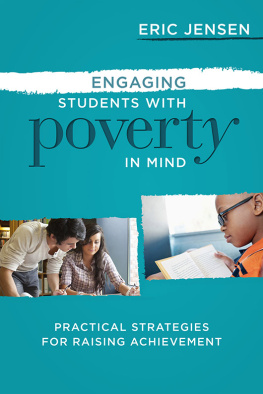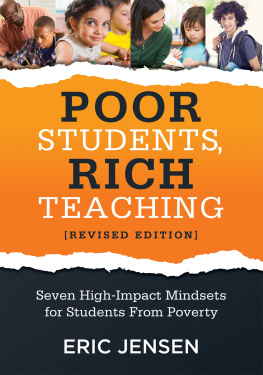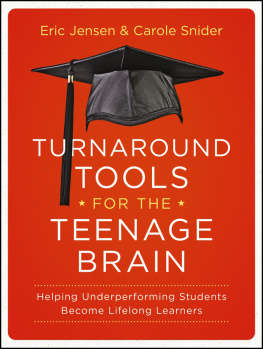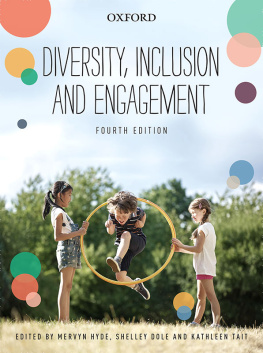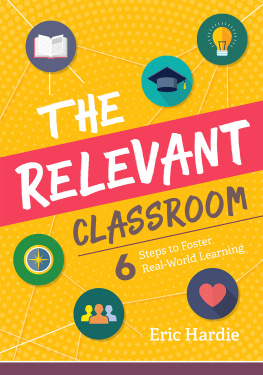Acknowledgments
....................
I am very grateful for editorial and research support from Nanette Metz, Ruth Fine, and Pam Rooks. I am continually indebted to professional contributions from Jean Blaydes, Bryan Harris, LeAnn Nickelsen, and Rich Allen. I am also grateful for the editors and publisher at ASCD, who have been very supportive of this project, and Miriam Goldstein, who has made incalculable contributions with her thoughtful editing.
Finally, my wife, Diane, is always supportive of my writing projects and is a never-ending blessing.
Preface
....................
Looking at this book's title, maybe you're wondering about a couple of things. What would I know about this subject? What gives me, a middle-class white guy, the right to do a book on poverty? A skeptical teacher actually e-mailed me these questions. I think they are valid, and I'll answer them with a short story about a real kid.
This boy's first memory was of standing in the living room of his house at age 2. Tears streamed down his cheeks. His mother sheepishly walked out the front door. It was the day the divorce went through. Four tumultuous years later, his father remarried for the second of four times. The first of the boy's three stepmothers was alcoholic and abusive. Both of his older sisters quickly moved out of the house, one to live with neighbors and the other to live in the garage.
At home, the young boy often ate dog food for snacks between meals because he was locked out of the house. From 2nd through 10th grade, he was terrorized by his violent stepmother. Blood and broken glass were commonplace in the house. Every time things got really bad, the father moved the boy and his sister to stay with relatives. Then the boy's stepmother would promise to be better, and the trio would move back. The boy lived with his grandmother, his aunt, his uncle, and then on his own. The cycle repeated itself every couple of years. School was a confusing and disconnected process. During those turbulent years, he went to nine schools and had 153 teachers.
The boy wasn't at any school long enough to develop real friendships. He was often truant and frequently got sent to the office for discipline issues. In class, he usually sat at the back, troubled and disconnected from the content. Mostly, he thought about what it was going to be like when he got home. For him, home was a war zone. Getting homework done was impossible in his environment. He had zero parental support, and his only friends were troublemakers. His dad was gone most of the time, going to night school and often spending weekends working in the National Guard. His dad was also engaged in an affair, which made for even more friction and accusations at home.
Why am I telling you about this child's upbringing? What do these experiences have to do with this book?
This is the true story of my own childhood. I'm not asking for sympathy. My upbringing was not of my choosing, so I accept neither credit nor blame. This is just a brief edited piece of my life story. (The reality was not nearly so G-rated.) My point is this: don't judge someone by his or her skin color, ethnicity, or socioeconomic status.
Just because I grew up white and middle-class does not mean I don't understand the real world. I've been arrested twice and had eight near-death experiences. I lived in a laundry room for two years and in a 15-foot trailer for five years. I've been kidnapped and held at gunpoint. I've been robbed, I've been a stowaway, and I've had to ride boxcars for over 1,000 miles to get home. I understand what it's like for the kid sitting in the back of the room who can't focus and spends the class worrying about what might happen when he goes home. I know what it's like to be hungry all the time. I was one of those kids.
Teaching students who live in povertyespecially teaching in a school with a high-poverty student population, like a Title I schoolexposes every single weakness a teacher has. If you don't learn, adapt, build relationships, and bring your A-game every single day, your class will be a living hell. If you're adaptive, if you dream big, if you care a lot, and if the impossible doesn't scare you, then your students will pick up on that and respect you. How do I know? Two middle school teachers made that difference in my life. They showed me empathy. They challenged me to do better, and they engaged me in class. I became a teacher because of them. I learned to focus, write, and learnand then to learn again, from my mistakes. Teachers can make a real difference in the lives of students who face continual adversity.
Some teachers tell me, Those kids just need more discipline. You have to show them who's in charge. It doesn't work that way. First, they are not those kids; they are our kids. The future of the United States depends on whether or not these kids succeed. They need loving, caring role models, not prison guards.
Second, if you want high-performing students, you must be willing to become a high-performing teacher. Stop pointing fingers and making excuses. Every student would rather have a caring, engaging teacher than a finger-pointer. The attitudes and strategies of yesterday are not enough anymore. It's time to upgrade your teaching.
Why am I encouraging you to set your own bar so high? If you're like most educators, it's likely you're pretty engaged with your work. You participate in meetings, take care of logistics, make phone calls and write e-mails, plan lessons, administer tests, and engage in a host of other activities. But what if you set the bar higher for your own classroom? I'm not saying, Work more hours. I am saying, What if your new bar was to reach far more students in far more engaging and profound ways? How engaging is today for every single one of your students?
You won't ever get good at your job if you stay the same. You'll still have underperforming students, and they will see through you with X-ray eyes. Teaching is easy; teaching well is hard work. If the only change you want to make is to add a few cutesy strategies, this book is not for you.
The truth is, teaching students well will change you. Let me repeat that: teaching well will change you. This book will enable you to understand the students you work with in new ways that will help you to help them succeed. If you are ready to take that journey, fasten your seat belt. It's going to be a wild ride.
Introduction
....................
The academic record of students who live in poverty is not good. In the United States, if you are poor, your odds of graduating are lower than are those of a middle-income student. If you are also Hispanic or black, your odds just dropped again. Half of all poor students of color drop out of school (Alliance for Excellent Education, 2008). Seventy percent of all children who do not graduate from high school have spent at least a year living in poverty (Hernandez, 2012). In 2009, the dropout rate of students living in low-income families was about five times greater than the rate of students from high-income families: 7.4 percent versus 1.4 percent (Chapman, Laird, Ifill, & KewalRamani, 2011).
This is not a failure within the students. There are no poor students with deficits; there are only broken schools that need fixing. There are no failing students; there are only schools that are failing our students. There are no unmotivated students; there are only teachers whose classrooms are frightfully boring, uncaring, or irrelevant. Such classrooms fail to engage students enough to be able to meet their needs. If you think these are outrageous statements, this book is for you. I'll show you the evidence and share the success stories.

